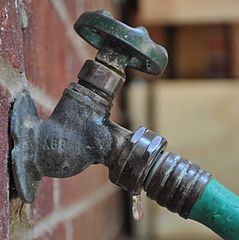A Low-Tech But Highly Effective Concept in Water Conservation
Frequent commenter Brian McGowan writes:
While I don’t have flush-free urinals in my house, I do collect the water from the water softener regeneration and the rinse cycles of my washing machine and use that to flush my toilet.
Brian, you are truly an inspiration to us all — to me, at least — with your incredibly creative and diverse use of energy efficiency devices. But trust me, you don’t want a waterless urinal in your house. It’s a great tool to reduce water use if you have dozens of flushes per hour, but I think (at least I hope) that’s not the situation at your house. Having said that, what you may want is suggested in the next paragraph.
I’m reminded of a visit I made years ago to a fine friend at least 40 years my senior, Kelly Kreyling, a somber gentleman, a philosopher of amazing proportion — a kind of modern-day H. D. Thoreau, I suppose. He lived in Southern Virginia (Fincastle, to be exact), and, essentially regardless of the weather, would walk outside to urinate. He once told me, “We live on top of the most effective filtration system one could possibly imagine – and we pee in our drinking water. That alone shows our depravity.”


My grandmother’s house had only 1 bathroom. We would visit for weekends and two weeks each summer and sometimes a week during the Easter break. My family (4 of us) my mother’s sister’s family (5 of them) my grandmother’s sister and my grandparents in one small house with one bathroom. Six men and six women. The woods behind her house was “the men’s room”.
I have done this in the woods behind my current house when power was down and I was still on the well but I am in a more populated area and have to be more careful.
Between the above and boy scouts I am not a stranger to this concept and not averse to using it : ))
Unless a significant number of people did that, the amount of water saved would be insignificant and one may be sure that a significant number of people will never do that.
To be effective, water conservation methods must be convenient and sanitary.
“Unless a significant number of people did that”
Isn’t that the same statement that could be applied to anything we talk about here?
Peeing in the woods is all very well but given the population density in cities would not be an acceptable solution in urban areas.
For anyone with a garden, composting toilets might be considered, and are almost certainly the best solution for water challenged areas. Ideally with these devices you pee in one section which drains off to the sewer and poo in the other where what you deposit slowly dries out and composts. Composting toilets use no water and use only a very small amount of electricity to run a small extraction fan – (around 2 watts). Some composting toilets have 2 composting sections which are swapped from time to time. Once the second section has rested for a few weeks it is removed from the toilet and its contents mixed into the compost heap. Section 1 with the fresher deposits then rotates out of use and is replaced with the now empty container.
For those wishing to use a home urinal, I would suggest a push button flush which only releases a small amount of flush water.
The bathroom sink is an easily cleaned urinal too! Only a cup or two of tap water will flush sink/urinal.
I will go as far as the soil sink in the basement to avoid tracking dirt through the house when I’m dirty. Washing my hands after “flushes” that nicely. Not sure how the wife would take to me using the bathroom sink.